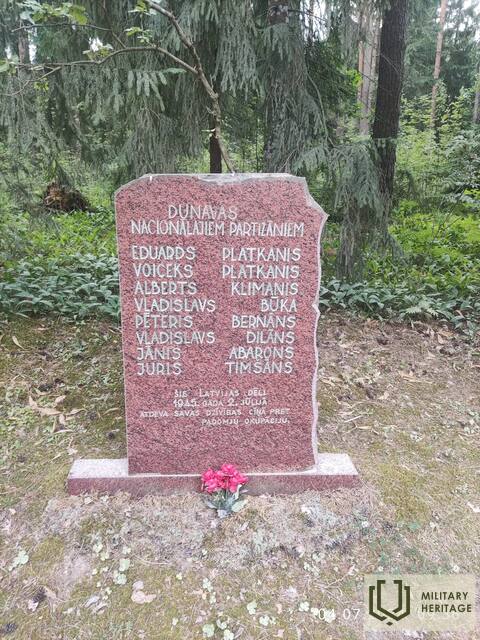Memorialas 1945 m. liepos 2 d. vykusių nacionalinių partizanų mūšio prie Dunojaus vietoje
Memorialinė vieta


 182
182



Atminimo akmuo 1945 m. liepos 2 d. Dunojaus mūšyje žuvusiems nacionaliniams partizanams Jāniui Abaronui, Vladislavui Būkui, Pēteriui Bernanui, Albertui Klimaniui, Vladislavui Dilanui ir Juriui Timšānui, vėliau sudegusiems Rubenės valsčiuje.
Dunavos mūšis kilo po to, kai birželio 30 ir liepos 1 d. vakare Ataugoje, Dunavos valsčiuje, per miškininkų ir sovietų okupacinės valdžios atstovų susidūrimus žuvo du Latvijos SSR Vidaus reikalų liaudies komisariato pareigūnai ir vienas milicininkas. Liepos 2 d. 16 tautinių partizanų, vadovaujamų Eduardo Platkanio, Rubenės kelio posūkyje už Dunavos kapinių kovėsi mūšyje su naikintojais, milicininkais ir Čekos kariais. Po kelių dienų, keršydami, Čekos pareigūnai sudegino Ataugos namus, o prie Rubenės valsčiaus salės viešai sudegino šešių tautinių partizanų, žuvusių Dunavos mūšyje, kūnus.
Panaudoti šaltiniai ir literatūra:
G. Blūzma. Nacionalinis partizaninis karas Sėlijoje // Pasipriešinimo judėjimas prieš okupacines valstybes Latvijoje. Ryga: SolVita, 1997, p. 276–278.
Nežinomas karas. Latvijos nacionalinių partizanų kova su sovietų okupantais 1944–1956 m. 1-asis leidimas. Ryga: Domas sūks, 2010, p. 365.
Susijusi laiko juosta
Susijusios temos
Susijusi istorija
Selio miško brolių gyvenvietė Sūpės pelkėje
Sūpės pelkė siejama su nacionalinių partizanų gyvenviečių ir mūšių vietomis, kurios susiformavo sąveikaujant žmonėms ir vietovėms. Ji aprašyta tremtinio latvių rašytojo Alberto Eglīčio baladėje apie įvykius jo gimtojoje Sūpės pelkėje „Samanose ir purve“ – duoklėje Sūpės pelkės partizanams:
... „1945 m., kai pelkėje švytėjo ruduo –
Pokļevinskio gimtadienio proga Lieljānis vakarienės metu dalijasi:
Gluosniuose fermentuotas alus,
Romulanai garbina sviestą,
Džiovinu mamos kmynų duoną,
Džiovintas kumpis kovo mėnesio gabalėliuose,
Ir Stučkos svogūnai,
Ildzeniecės sūris.
Kambariai dervingose sienose
Ir žaibas trenkė širdyse,
Ir vienuolikoje sielų merdi –
"Žemėje supuvusios šaknys..."
Ši praeities interpretacija su įvykiais po Antrojo pasaulinio karo apėmė žmonių liudijimus, dvasios išraiškas ir vertybių sistemas. Ji primena visuomenės paramą nacionaliniams partizanams, kurių okupacinė valdžia negalėjo taip lengvai nugalėti.






